How do you know what to bring on a camping trip? And once you have your comprehensive list of things to take camping, how do you work out how to use that stuff so you know how to set it up when you’re out in the woods?
This post includes a full camping checklist, plus advice on how to ensure you know about all the essential things to bring camping.
This camping packing list and advice in this article are especially for you if you don’t have much camping experience or if you haven’t been for a long time.
Camping Essentials Checklist
Before we jump into the full camping packing list, remember that if this is your first time camping and it looks like you need to buy a lot of ‘stuff’ don’t worry…
Consider buying used outdoor gear instead of getting it brand new, either from your local outdoor store or by searching used gear online at REI’s dedicated Used Gear site.
Learn more: how to buy used gear from REI.
1. Shelter, Bedding and Chairs
ESSENTIAL:
- Tent – don’t forget tent stakes (if you need a tent, read our guides to lightweight tents and hammock tents for some inspiration)
- Sleeping Bag and Pad/Mat – such as one of these lightweight options. For more comfort, if you’re sleeping as a couple or simply want to spread out, consider a double sleeping bag
- Sleeping Pad – or air mattress including a pump, if needed to inflate it
- Multi-Tool – as these are so useful we consider them essentials for camping as well as to have in your car and to take hiking, too.
- Pillows – either specific camping pillows or your favorite from home
- Camping Chairs – we like lightweight, folding camping chairs that pack down small when not in use, or you could go or a more comfortable heated option like the Gobi Heat chair if you want to live it up
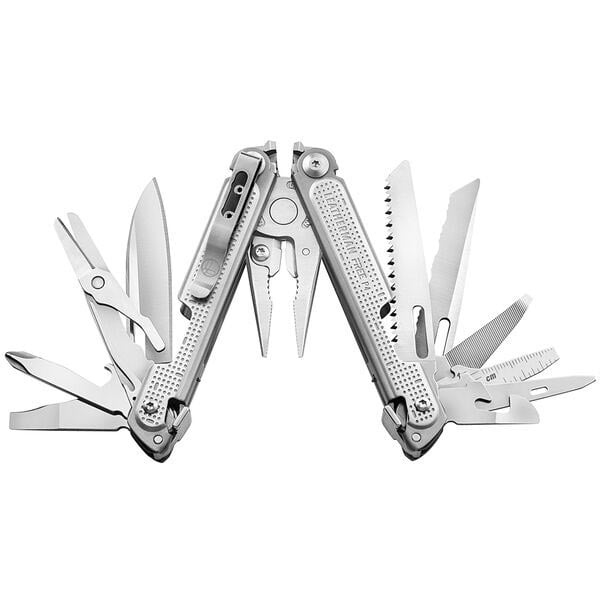
OPTIONAL:
- Camp Table – if no picnic table at your campsite, you’ll probably need a table for cooking.
- Separate Shelter – for protection from the weather and bugs.
- Tent Footprint – unless your tent comes with one, like the REI tent pictured above does.
- Hammock – either freestanding or to attach to trees/posts (if permitted at your site) – see our camping hammocks buyer’s guide for some great options.
- Camp Lanterns – We like rechargeable solar options – our camping lanterns guide for our recommendations.
- Mallet – to get tent stakes into hard ground.
- Camp Shower – if there won’t be facilities where you’re campsite is, this is a simple and cost-effective option.
- Paracord and Duct Tape – as a repair kit for making fixes (make sure you have a multi-tool to cut it with).
- Tarpaulin (with eyelets) or shade structure – useful for staying out of the sun or keeping gear and firewood dry.
- Portable Power Station or Power Bank – for easily charging your phone, headlamp, camping lantern and other electronics consider getting a portable power station with solar charger capability.
- Campfire Prep Gear – for example, a hatchet, firewood (if you can’t get any at your campground) and a lighter.
- Walkie Talkies – very useful for emergencies or camping in areas with little or no cell signal. Our top recommendation is the Rocky Talkie – learn more about them in our Rocky Talkie review.
2. Food and Camp Kitchen Essentials
For a complete Camp Kitchen checklist and buyer’s guide with advice on how to choose the best outdoor camping kitchen gear visit our Camp Kitchen Buyer’s Guide.
ESSENTIAL:
- Cooler – a quality cooler will keep your food and drink cold for several days at a time
- Water Bottles – great for around camp as well as day trips and local hikes
- Flasks and / or Growlers and Mugs – for water and other beverages
- Water – it’s always sensible to bring a container of potable water especially if you’re not sure of the source of local water for drinking and cooking with. Some more rustic campgrounds don’t have running water on site.
- Food – enough food for your trip, or until you can re-supply (make sure it all fits in your cooler!)
- Cooking Essentials – spices, oils, salt, sauces, etc
- Camp Stove – plus gas. Something like this Eureka camp stove is a great compact option. Or, level up your camp cooking game and get yourself a portable stone-baked pizza oven like the Solo Stove Pi.
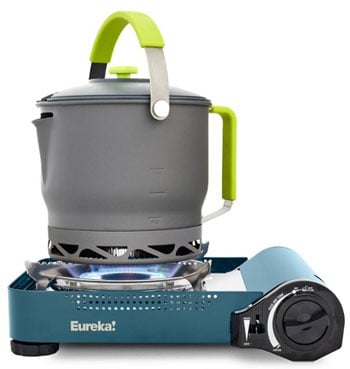
- Cooking Utensils – including silverware, sharp knives and cutting boards, can and bottle opener, measuring cups if you need them.
- Cooking pots and pans – compact stackable sets are a good investment if you plan to camp often. A dutch oven is also a versatile camp kitchen item.
- Plates / Bowls – consider mess kits for a durable, stackable option
- Drinks – tea, coffee, alcoholic beverages
- Washing-Up – biodegradable soap, tub and dish cloths
- Trash bags – pack it up and out with you in plastic bags if you’re in an undeveloped camping area
OPTIONAL:
- Water purifier – like the Grayl Geopress water bottle which filters and purifies water from any source around the world in just 8 seconds. Also consider a LARQ UV Purifier bottle for this purpose. To learn more about how to filter and purify water in the backcountry read our backpacking water filter & purifier buyer’s guide.
- Grill – including tongs and other grill cooking utensils
- Campfire making supplies – including a firestarter and firewood
- Bear Canister (or Food Hanging Bag) – to keep food out of paws’ reach
- Paper Towels
3. Clothing items
ESSENTIAL:
- Pants
- Shorts
- Short Sleeve Tees
- Long Sleeve Shirts
- Pajamas or Something to Sleep In
- Socks – sweat-wicking, odor-control socks like Merino socks are a great choice
- Underpants
- Bras
- A hat or cap – for weather protection
- Waterproof Jacket
- Warm Down Jacket (or synthetic puffy jacket equivalent) – these are a good idea as they pack down small and provide lightweight warmth
- Sunglasses – we recommend polarized lenses especially if you’ll be on or near water as they minimize reflections and glare
OPTIONAL:
- Gloves
- Swimming wear
- Down / synthetic puffy vest
- Buff or bandana
- A warm hat – if you expect to need it given the climate and how cold the evenings get
4. Footwear
ESSENTIAL:
- Hiking Boots and / or Trail Running Shoes – if you need to buy a pair of boots or trail shoes, visit our hiking boots buyer’s guide and trail running shoes buyer’s guide for help choosing.
OPTIONAL:
- Sandals or Flip Flops
- Water Shoes
5. Personal and useful camping gear
ESSENTIAL:
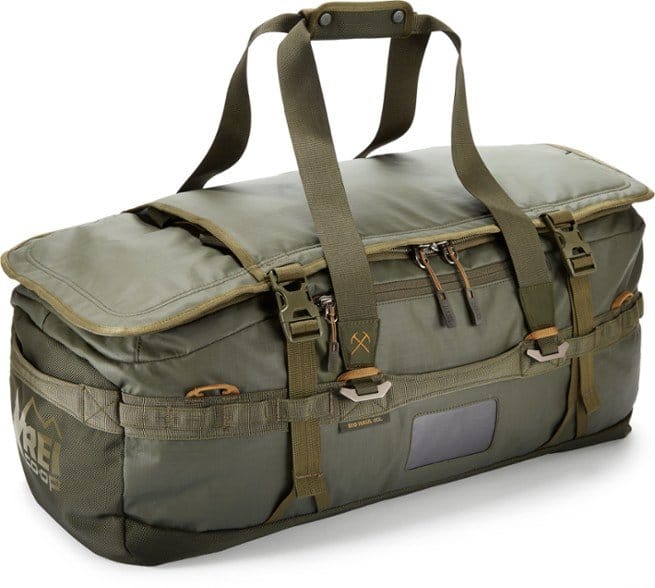
- Duffel Bag – Much easier than a suitcase when it comes to packing your clothes, footwear, toiletries, and other personal items – or go one better with a system like RUX (learn more about that in our RUX 70L review)
- Daypack – for packing smaller items in and to take on day hikes and local trip
- Quick-Drying Microfiber Towels – These are a significant upgrade over regular heavy cotton towels when you’re camping – here are some of the best quick-dry camping towels
- Personal Hygiene and Medications – all the usual things you need with you, including soap, shampoo, conditioner, baby wipes, lip balm, makeup, makeup remover, moisturizer, toothbrush and toothpaste, deodorant, etc, in miniature travel sizes if you need to save space
- First Aid Kit – It’s always worth having a first aid kit with your camping gear, as well as one in your car
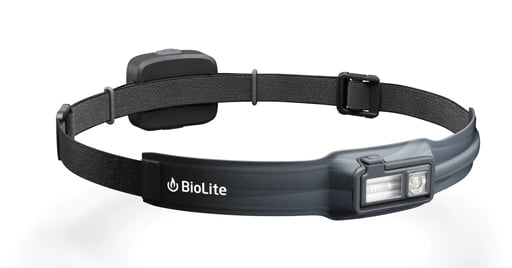
- Headlamp – headlamps are more versatile than a torch. It’s best to bring one with a red light function to avoid waking and dazzling others when you look directly at them
- Sunscreen
- Insect Repellant – if insects are likely to be an issue, consider taking bug nets and other bug protection
- Toilet Paper
OPTIONAL:
- Sanitary trowel for camping in places with no bathroom.
- GPS Watch or Handheld – for local hikes and adventures, especially if phone signal is questionable. Here are our recommended GPS watches for running and hiking.
- Umbrella – useful for the sun as well as the rain
- Laundry Bag for Dirty Clothes – keep the stinky stuff separated within your duffel bag for the trip home.
If you plan to do some hiking when you’re on your camping trip then read our day hiking checklist next for a list of recommended gear to take with you.
6. Entertainment
The options are endless when it comes to entertainment ideas for camping; our preferences include:
- Playing cards (for when it’s not windy…)
- Binoculars for stargazing or bird watching – Read our Beginner’s Guide to Stargazing for some stargazing tips
- Your dog(s). Our dog, Kepler provides hours of entertainment, whether we are at home, camping in the yard, or out somewhere adventurous 🙂 Don’t forget a pet sleeping bag, their bowl, toys, leash and food!
- Books – I’m learning about the wildflowers of the Western US and have plans to learn about what is edible and what is definitely NOT edible!
- Local Maps for exploring the area
- Parks Passes / Season Passes for campgrounds and visiting local parks
- Running gear for trail runs nearby – if you haven’t been trail running before but like the sound of it, check out our beginner’s guide to trail running for what to wear and how to get started
- Camera – or perhaps an action video camera like a Go Pro. Don’t forget your tripod for long exposure or timelapse shots!
- Extra batteries and a battery charger with charging cables for your camera, GPS and other gadgets.
- Stand Up Paddle board or Kayak – plus paddles and gear such as buoyancy aids
What to Bring on a Camping Trip
By the end of this guide, you’ll have a very clear picture of what things you need for camping.
Climate and location of your campsite
Considering the climate and location of your camping destination will help you be prepared for the elements and other factors such as bugs and humidity.
Specific considerations for your camping checklist include:
- Will you need to pack warm clothes for cold evenings?
- Will you need to ensure you’re staying cool in the heat of the day?
- Are there sandflies, mosquitos or other bugs in the area?
- What’s the UV index in the area where you’ll be camping?
- Is your camping destination exposed to strong winds?
- Does the campground have cell service
If you’ll be camping near a lake in summer then the bugs are definitely a consideration.
If you’re camping at altitude or in the desert then cooler evenings are likely, even if it’s very hot during the day.
‘Shoulder season’ either side of the summer may be better for popular camping areas, as you’ll have more chance of it being quieter, less expensive, and easier to make a reservation if reservations are required. However, you may need to be more prepared for wet or cold weather.
The time of year you go will therefore influence what to take camping so it’s worth researching the area’s climate and average temperatures, wind and precipitation in that month so you know what the weather could be like. It’s also a good idea to check the weather forecast before you leave home.
What campsite facilities will you have access to?
When working out what to pack for camping it pays to consider what to expect from your campsite and how remote your camping spot will be.
Will you be somewhere with a bathroom? Will there be any stores nearby? Is there somewhere to throw away waste?
Depending on what facilities you are expecting, you may need to think about being more self-sufficient in terms of how much stuff to bring camping to ensure you have enough food, water, personal hygiene and first aid kit supplies.
If you’re camping off-grid somewhere with no bathroom or trash cans, also consider how and when you’re going to dispose of your waste responsibly, and bring extra trash bags for packing it out.
How long will you be camping for?
If you are going for an overnight or weekend camping trip then you will not need to bring as many things with you – which includes the number of meals and amount of water and clean clothes you may want.
Once you start looking at more than a few days of camping then it’s worth paying additional consideration to practicalities such as how you’ll restock on food and drink and how you’ll charge your electronics such as your phone and camera, if you’ll have them with you.
Advice on choosing specific items of camping gear
What to consider buying used
While you can buy a whole range of outdoor gear used, these are the most expensive pieces of camping and hiking gear that are often available used on REI’s used gear website.
If you need to buy one of these for your camping trip, I highly recommend doing a search and seeing if you can find a great deal on there (most of these items are basically new and have been returned, or very lightly worn):
- Tents
- Sleeping bags and pads
- Camping stoves and kitchen cookware
- Waterproof and warm down / synthetic jackets
- Camp chairs, hammocks and tables (unless your campsite has a picnic table)
- Backpacks and duffel bags
- Hiking boots and trail running shoes
Choosing a tent and sleeping bag
If you’re camping near your car then you do not need to have an expensive lightweight tent, and can get away with a bigger, sturdier (and often less expensive) tent that has double layers to reduce the impact of condensation building up overnight, especially in wetter climates.
Also, depending on your tent, it may be worth buying a tent footprint or a tarpaulin to place under the tent, to protect the tent material from snagging on the ground.
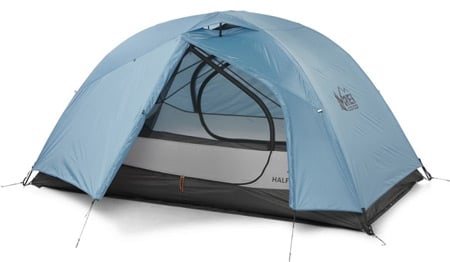
If you’re camping in your car then you obviously don’t need to take a separate tent, unless it is intended to give you more space and storage for your stuff while you’re on your camping trip!
You’ll need to bring a sleeping bag on most camping trips, so it makes sense to get a good quality one that will stand the test of time.
Unless you intend to camp in conditions below freezing, or in winter, then for most people good quality three-season sleeping bags are perfect for camping trips – here are some of the best sleeping bags and pads currently available.
If you are camping as a couple then I highly recommend looking into double sleeping bags and 2-person sleeping mats to go with them. Don’t forget a puncture repair kit for your inflatable air mattress or pad!
Especially if you are going to be car camping, this is a great way to sleep overnight together without both being restricted in separate one-person mummy-style sleeping bags.
To add comfort to your sleeping arrangement, we suggest getting a sleeping pad, that will insulate you from the cold of the ground, and also provide some padding to help get a good night’s sleep when the ground is uneven.
Finding the best footwear to take camping
Whether or not you’re actually doing any hiking, it makes sense to take a pair of hiking boots, or at least trail running shoes, with you on your camping trip, to protect your feet from obstacles, especially at night whether it’s harder to see where you are stepping.
We also like to take flip-flops or sandals with us for wearing around camp and giving our feet a breather.
Dn’t forget to pack good quality natural fiber hiking socks. We recommend those made from Merino wool for their natural anti-stink and sweat-wicking properties.
Ensuring you have clean drinking water
Even if there should be access to a drinking water source at your campsite, I strongly suggest taking your own water supply just in case the quality of the water there is dubious.
It’s also worth having a water purification and filtration device if the water supply where you’ll be camping is not from a drinking supply.
Keeping your food secure
If you’re going somewhere in ‘bear country’ then there are additional special considerations regarding where you store your food and toiletries at your campsite.
It needs to be somewhere away from your campsite and out of reach from bears – make sure you do your research before you go to know the rules and guidance, and whether you need to invest in a bear canister – many campgrounds provide lockers specifically for storing these items.
Suitable clothes to pack for camping
The best clothes for camping are similar to the type of clothes you may wear hiking, and are best worn in layers.
At the very least, we take some quick-drying pants, shorts, t-shirts, a warm down jacket and a waterproof jacket, plus items we can sleep in.
Also, don’t forget a good cap and sunglasses combo! Both will protect your head and eyes from the elements – whether that’s the sun, wind or rain, it’s a good idea to have these with you.
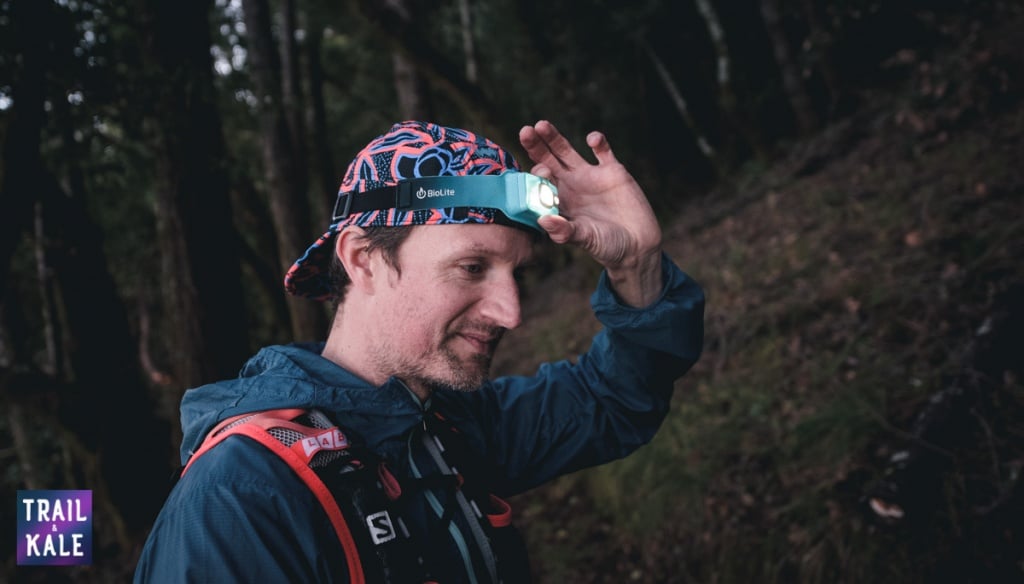
Choosing a headlamp
Trust me, you’ll want a good headlamp. You need to be able to see what you’re doing once the sun goes down, when you’re in camp, inside your tent, rummaging for stuff in your bag, or navigating your way to a suitable bathroom area in the middle of the night.
BioLite headlamps are also perfect for hiking and trail running
A good quality headlamp is another useful item to have at home in case of emergencies, as well as for backpacking, hiking, and trail running.
Taking a headlamp with a red light function is important for camping, as it means you can use that light in the night without unnecessarily disturbing or temporarily blinding other people camping with you.
Also, consider a small rechargeable lantern – these are excellent accessories to have with you during adventures.
How to pack your camping gear
With all of the gear on this camping packing list, you need a bag to put it in. Packable soft duffel bags are a great choice because you can fold them down small when they’re empty or only half-full, to save on space.
We suggest also taking a small backpack even if you’re car camping because you can use it for day-hikes, it will keep your smaller items organized, and it’s easy to carry over uneven ground.
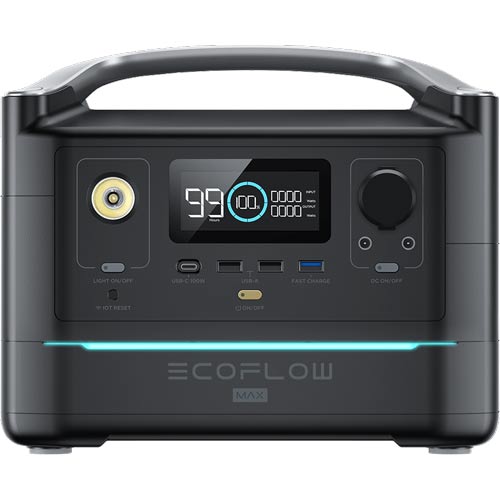
Camping gear for home emergencies
A great thing about buying good quality gear is that it’s not just to take camping – this gear can also be very useful to have at home in the case of an emergency.
Camping gear that is useful in an emergency includes portable power stations, lanterns and headlamps (if there’s a blackout), emergency food, and other camping must haves such as a first aid kit or sleeping bags for extra warmth if there’s a power cut in the middle of winter.
That brings us to the end of our camping checklist and tips on what to bring camping. Now you’ve read the full guide, click here to jump back up to our camping checklist to work through what to pack for your next trip.
Thanks to REI for continuing to support us so that we’re able to share this camping checklist and advice.
Being an REI member not only entitles you to an annual dividend on everything you spend there, but you get access to exclusive sales and pricing, as well as being part of an outdoor-loving community and co-op that supports important causes that matter.
For more information about REI membership and why we’re such big fans of the REI Co-Op, click here.
I hope this camping checklist and guide has helped you work out what to take with you on your next camping trip, whether you’re going basic or luxury. However you do it, it’s a great way to spend time in nature.











Great article ,very helpful !